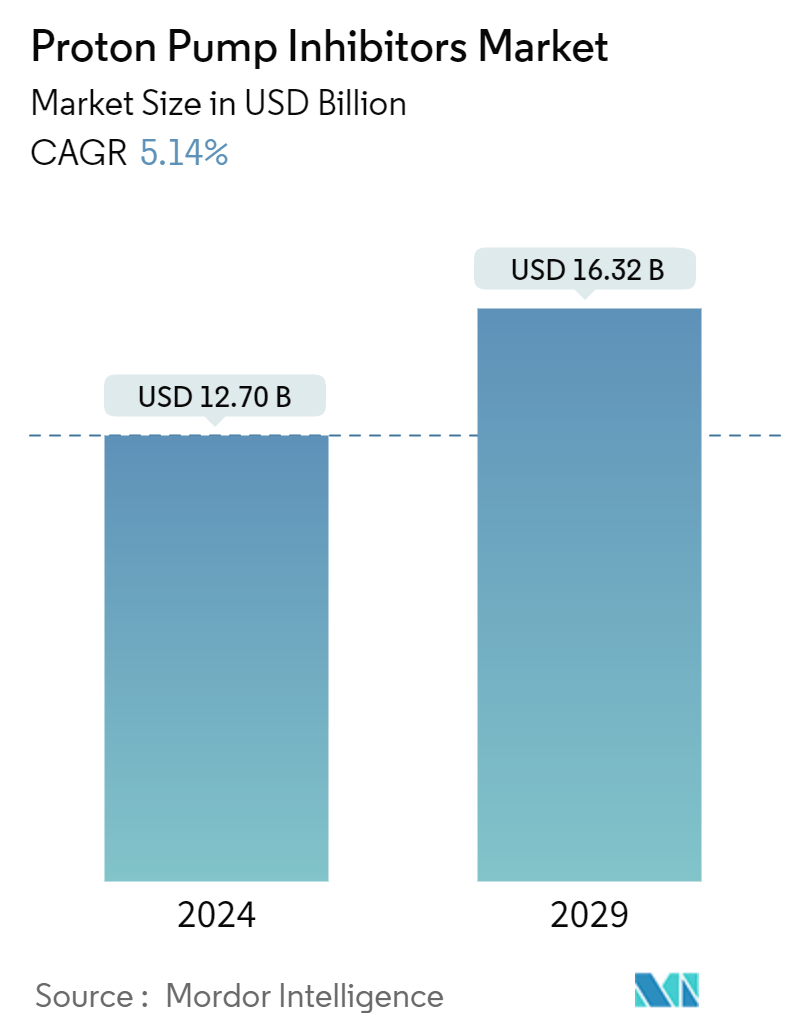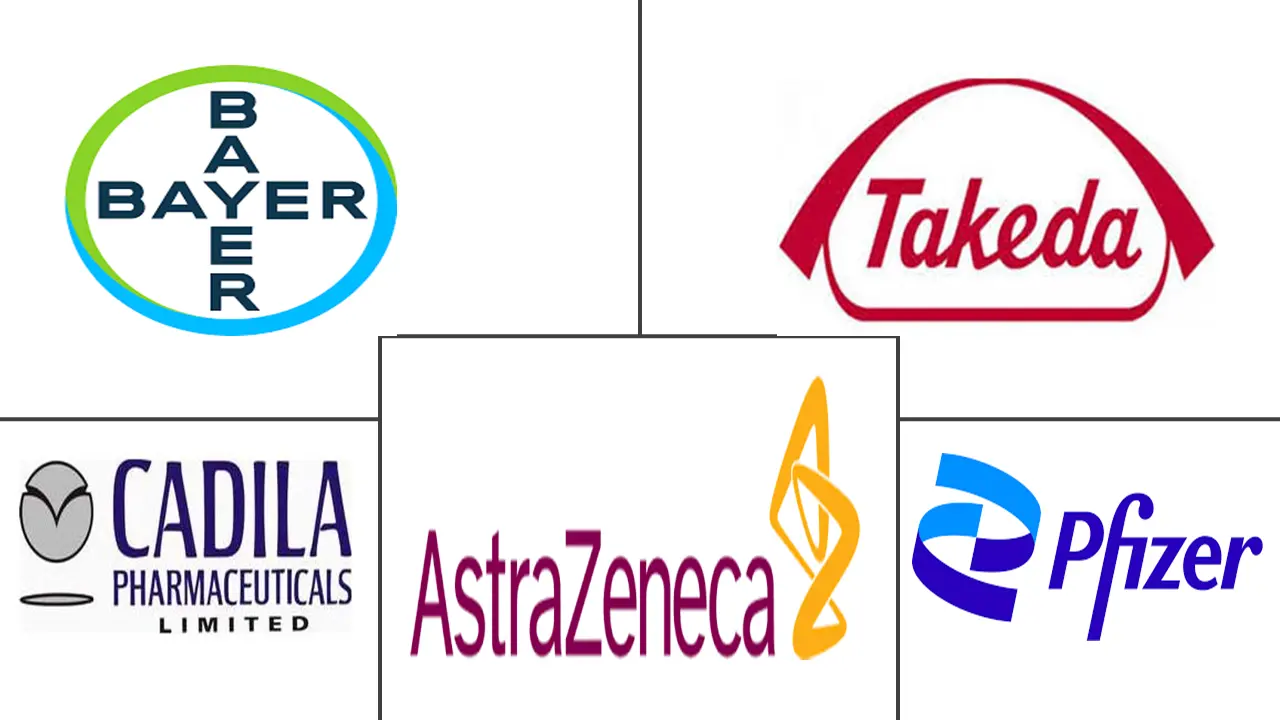Market Size of Proton Pump Inhibitors Industry

| Study Period | 2019 - 2029 |
| Market Size (2024) | USD 12.70 Billion |
| Market Size (2029) | USD 16.32 Billion |
| CAGR (2024 - 2029) | 5.14 % |
| Fastest Growing Market | Asia Pacific |
| Largest Market | North America |
Major Players
*Disclaimer: Major Players sorted in no particular order |
Proton Pump Inhibitors (PPIS) Market Analysis
The Proton Pump Inhibitors Market size is estimated at USD 12.70 billion in 2024, and is expected to reach USD 16.32 billion by 2029, growing at a CAGR of 5.14% during the forecast period (2024-2029).
Many researchers have found that proton pump inhibitors have increased the risk of COVID-19 in patients taking these medications. An article published by PubMed Central in February 2022, reported that proton pump inhibitors (PPI) use was marginally associated with a nominal but statistically significant increase in the risk of COVID-19 infection, and PPI use also increased the risk of poor outcomes in patients with COVID-19. This factor affected the market growth as patients undergoing proton-pump inhibitor therapy was advised to consume fewer medications and avoid these medications unless it is an emergency. Thus, COVID-19 has a significant impact on the growth of the studied market. However, currently, as the pandemic subsided and fewer people are getting infected with the virus, the studied market is expected to have favorable growth during the forecast period of the study.
Proton pump inhibitors are the gold standard medication for gastroesophageal reflux disease (GERD), and the increasing prevalence of GERD and the rising acceptance of novel drug delivery systems are the two most prominent factors driving the growth of the market.
Additionally, the risk factors, such as aging, obesity, delayed stomach emptying, changing lifestyles associated with smoking, and consumption of alcohol, coffee, fatty, and fried foods are the major reasons for the occurrence of GERD. Furthermore, according to the data published by WHO in October 2022, it is estimated that by 2030 1 in 6 people in the world will be aged 60 years or over, and by 2050, the world's population of people aged 60 years and older will double to 2.1 billion. With the increasing geriatric population, the usage of proton pump inhibitors is expected to increase as aging is a major risk factor for GERD. Hence, this factor is expected to enhance the market growth.
Furthermore, players in this market are developing novel products and coming up with new product launches to leverage market opportunities. For instance, in March 2021, Xiromed LLC, the New Jersey-based generic division of Insud Pharmaceuticals, launched Omeprazole Delayed-Release Capsules, 20mg, generic for Prilose. Such a launch of drugs is propelling the growth of the market.
Thus, the increasing prevalence of GERD, along with the growing risk factors are likely to increase the demand for proton pump inhibitors, which is expected to drive the market's growth. Also, the increasing shift from prescription to OTC drugs is driving the growth of the proton pump inhibitor market. However, the increasing use of generic products in the market and the side effects associated with the drugs may hamper the market growth.
Proton Pump Inhibitors (PPIS) Industry Segmentation
As per the scope of the report, proton pump inhibitors (PPIs) are a group of drugs whose main action is the long-lasting reduction of gastric acid production. They are the most potent inhibitors of acid secretion available.
The Proton Pump Inhibitors Market is Segmented by Drug Type (OTC Drugs (Omeprazole, Lansoprazole, Esomeprazole, and Other OTC Drugs) and Prescription Drugs (Rabeprazole, Dexlansoprazole, Pantoprazole, and Other Prescription Drugs) and Geography (North America, Europe, Asia-Pacific, Middle East & Africa, and South America). The market report also covers the estimated market sizes and trends for 17 different countries across major regions. The report offers the market sizes and forecasts in value (USD million) for the above segments.
| By Drug Type | ||||||
| ||||||
|
| By Geography | ||||||||
| ||||||||
| ||||||||
| ||||||||
| ||||||||
|
Proton Pump Inhibitors Market Size Summary
The proton pump inhibitors market is poised for significant growth, driven by the increasing prevalence of gastroesophageal reflux disease (GERD) and the rising acceptance of novel drug delivery systems. As the gold standard for GERD treatment, proton pump inhibitors are experiencing heightened demand due to factors such as aging, obesity, and lifestyle changes that contribute to the condition. The market is also witnessing a shift from prescription-only medications to over-the-counter availability, further propelling growth. Despite challenges like the potential side effects of these drugs and the rise of generic alternatives, the market is expected to expand as major players focus on research, development, and strategic initiatives to introduce new formulations and enhance market presence.
North America currently leads the proton pump inhibitors market, with a strong demand driven by unhealthy lifestyle choices contributing to a high incidence of GERD. The United States, in particular, shows a significant increase in PPI prescriptions, supported by aggressive marketing and awareness campaigns. The market's growth is further bolstered by product launches in the generic category, which offer therapeutic equivalents to branded drugs. The market remains moderately fragmented, with key players like AstraZeneca, Bayer AG, and Pfizer actively competing for market share through strategic partnerships and product innovations. As the market evolves, the introduction of new drugs and formulations is expected to sustain its growth trajectory over the forecast period.
Proton Pump Inhibitors Market Size - Table of Contents
-
1. MARKET DYNAMICS
-
1.1 Market Overview
-
1.2 Market Drivers
-
1.2.1 Increasing Burden of Gastroesophageal Reflux Disease (GERD)
-
1.2.2 Rising Acceptance of Novel Drug Delivery Systems
-
-
1.3 Market Restraints
-
1.3.1 Increasing Use of Generic Products
-
1.3.2 Side Effects Related to Proton Pump Inhibitors
-
-
1.4 Industry Attractiveness - Porter's Five Forces Analysis
-
1.4.1 Threat of New Entrants
-
1.4.2 Bargaining Power of Buyers/Consumers
-
1.4.3 Bargaining Power of Suppliers
-
1.4.4 Threat of Substitute Products
-
1.4.5 Intensity of Competitive Rivalry
-
-
-
2. MARKET SEGMENTATION
-
2.1 By Drug Type
-
2.1.1 OTC (Over-the-counter) Drugs
-
2.1.1.1 Omeprazole
-
2.1.1.2 Lansoprazole
-
2.1.1.3 Esomeprazole
-
2.1.1.4 Other OTC Drugs
-
-
2.1.2 By Prescription Drugs
-
2.1.2.1 Rabeprazole
-
2.1.2.2 Dexlansoprazole
-
2.1.2.3 Pantoprazole
-
2.1.2.4 Other Prescription Drugs
-
-
-
2.2 By Geography
-
2.2.1 North America
-
2.2.1.1 United States
-
2.2.1.2 Canada
-
2.2.1.3 Mexico
-
-
2.2.2 Europe
-
2.2.2.1 Germany
-
2.2.2.2 United Kingdom
-
2.2.2.3 France
-
2.2.2.4 Italy
-
2.2.2.5 Spain
-
2.2.2.6 Rest of Europe
-
-
2.2.3 Asia-Pacific
-
2.2.3.1 China
-
2.2.3.2 Japan
-
2.2.3.3 India
-
2.2.3.4 Australia
-
2.2.3.5 South Korea
-
2.2.3.6 Rest of Asia-Pacific
-
-
2.2.4 Middle East & Africa
-
2.2.4.1 GCC
-
2.2.4.2 South Africa
-
2.2.4.3 Rest of Middle East & Africa
-
-
2.2.5 South America
-
2.2.5.1 Brazil
-
2.2.5.2 Argentina
-
2.2.5.3 Rest of South America
-
-
-
Proton Pump Inhibitors Market Size FAQs
How big is the Proton Pump Inhibitors Market?
The Proton Pump Inhibitors Market size is expected to reach USD 12.70 billion in 2024 and grow at a CAGR of 5.14% to reach USD 16.32 billion by 2029.
What is the current Proton Pump Inhibitors Market size?
In 2024, the Proton Pump Inhibitors Market size is expected to reach USD 12.70 billion.

